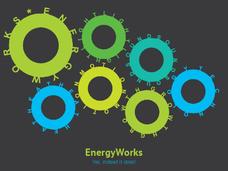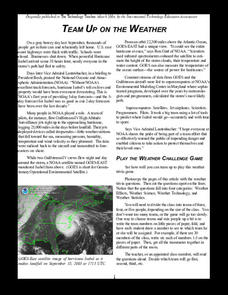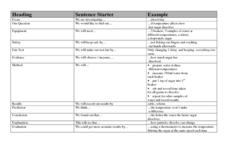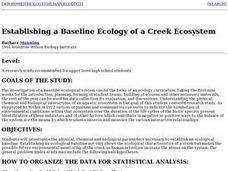Curated OER
Roaming Biomes
Students use the Internet to research the capabilities of earth-observation satellites. Using the information, they write a report on how remote-sensing technology is used to measure the impact of climate change. They identify the...
Curated OER
Winds of Destruction
Fourth graders discuss the problems that have arisen from the lastest string of hurricanes and tsuanamis. They watch a video about severe weather. After the film, 4th graders write four facts they found out about severe weather. ...
Curated OER
A Cosmic Cafeteria
Students indentify and differentiate between transit and surface food systems. Students measure energy that is released by various foods. Students compare and contrast cooking with solar energy on earth and what they might have learned...
Curated OER
Color Dots 3
Students make simple observations, test mixtures, and make generalized inferences from their observations. They observe bleeding of colored inks with water.
Curated OER
Making Paper
Fourth graders investigate the paper usage in their classroom and in other countries by using estimation, counting, and measurement skills. They make paper from recycled paper.
Montana State University
What's the Weather?
How many jackets do you need to stay warm and climb Mount Everest? An informatie resource covers the topic of Mount Everest, the resource helps young scientists discover the difference between climate and weather. Activities include...
Discovery Education
Sonar & Echolocation
A well-designed, comprehensive, and attractive slide show supports direct instruction on how sonar and echolocation work. Contained within the slides are links to interactive websites and instructions for using apps on a mobile device to...
Captain Planet Foundation
Solar Cooking Race
Study heat transfer with activities that focus on how heat energy works. Using a solar cooker, ice cubes, and heat transfer bracelets, kids experiment and record what they find by keeping ice cubes cold and vegetables hot.
Curated OER
Fahrenheit vs Celsius
Students make a thermometer and write a paragraph about how they did it.
National Energy Education Development Project
Energy Works: Yes, Indeed it Does!
Moving from its definition to how it moves and its different types, scholars see different examples and then move into its application and use in everyday lives, in an energy-based presentation.
International Technology Education Association
Team Up on the Weather
There's a little bit about every aspect of weather in this trivia game. The lesson resource provides 36 questions and answers pertaining to four different topics related to weather: effects, science, technology, and statistics. Groups...
Curated OER
Bacterial growth
Students explore the exponential growth and decay of microbial populations in relation to the organism tolerance ranges in their environment, They observe the impact of changing variables which can affect microbial populations.
American Museum of Natural History
What do you Know About Climate Change?
Test the class's knowledge of the key components of climate change. A 10-question online quiz asks learners about weather, climate, greenhouse gases, and several other concepts related to climate change. Interactive and easy for...
GED Testing Service
Achieve More: The GED Test
By 2018, 63% of US jobs will require a college degree or professional certificate. This is just one of the many great informational points you'll find on this handout, which you can use to inform your student body with the necessary...
Teaching Ideas
Investigation Prompts
Get your class started with experimentation and investigation by providing sentence starters. This chart is made up of three columns. The first column lists steps of the scientific process and the second provides sentence starters for...
Curated OER
Molar Mass of Butane
This lab sheet gives a detailed procedure for your class to find the mass of Butane. There is a complete guide for calculations, data analysis, and conclusion.
Curated OER
Nature and Fitness Trail
Students plan stations for a nature and fitness trail and construct an accompanying e-Book for extended descriptions at each station. Data on the human impact on the environment is gathered in this activity.
Curated OER
Your Own Fresh Water Aquarium in the Classroom
Learners explore aquariums. In this fish and ecosystems lessons, students establish a freshwater aquarium environment using materials provided. Learners read about and care for the classroom fish.
Curated OER
Energy and Changes of State
Young scholars complete a variety of labs to help them explain how energy affects the changes in states of matter. They also be required to collect and record data, graph data, and apply interpretations of that data.
Curated OER
Too Much Oxygen or Too Little?
In this oxygen worksheet, learners analyze date about the oxygen levels in a river to determine the cause of the dying fish. This worksheet has 2 graphs, 12 short answer questions, and 2 graphic organizers.
Curated OER
Your Own El Nino
Learners conduct an experiment. In this El Nino lesson, students learn where El Nino storms come from, what they consist of and what effects they have. Learners also complete an experiment where they create a miniature El Nino.
Curated OER
Pressure and Volume of Gases
Learners investigate pressure and volume as they relate to gases. In this pressure and volume lesson plan, students observe multiple demonstrations related to air pressure. The develop an understanding of the relationship between...
Curated OER
Bog Science
Learners study bogs. They tour, collect physical, chemical, and biological data and analyze a pristine bog community. Using the data, they draw a map and a cross section of the bog.
Curated OER
Establishing a Baseline Ecology of a Creek Ecosystem
Students investigate the physical, chemical and biological parameters necessary to establish an ecological baseline. Establishing an ecological baseline not only shows the ecological characteristics of a creek but makes the possible...

























